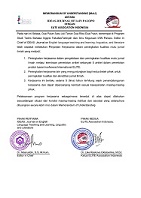ERROR ANALYSIS IN TRANSLATING ENGLISH FROM INDONESIAN OF SEMESTER SIXTH STUDENTS OF COKROAMINOTO PALOPO UNIVERSITY
DOI:
https://doi.org/10.24256/ideas.v3i2.147Keywords:
Error analysis, discourse errors, syntactic errors, lexical errorsAbstract
This research is aimed to know the students errors in translating English from Indonesian from several text of the semester fifth students of Cokroaminoto Palopo University academic year of 2014/2015, some people considered translating is one of the most difficult skills in learning language, some people considered translating Indonesian to English even more difficult than translating English into Indonesian.
The instrument consists of 17 texts as source language. Each text consists of several paragraphs which form a discourse. The paragraphs are from “Buku Dongeng Anti Korupsi Seri 1”. The translators are the undergraduate students of fifth semester of Cokroaminoto University. Data is located in the students’ English translation as target language. Data classified into 1) discourse errors, 2) syntactic errors, and 3) lexical errors. Syntactic errors will be classified into 1) sentence function, 2) tenses, 3) word order, 4) agreement rules, and 5) construction. Each sub-class is further sub-classified. Lexical errors are sub-classified into: 1) misselection of words, 2) derivational suffixes, and 3) function words.
References
Aronoff, M., &Fudeman, K. 2011.What is morphology (Vol. 8).Wiley.com.
Belloc, Hilaire.1931.On Translation. The Clarendon Press, Oxford.
Bell, R. T. 1991. Translation and Translating: theory and practice. London: Longman,
Borsley, R. 1999.Syntactic Theory: A Unified Approach (2nd Edition). London: Arnold.
Chaudron C. 1977. Teachers’ priorities in Correcting Learning Learners’ Errors in French Immersion Classes. Working Papers in Bilingualism 12: 21-44.
Corder.SP.1981. Error Analysis and Interlanguage. Oxford, Oxford University Press.
Dulay, H., & Burt, M. 1974. Natural sequences in child second language acquisition.Language Learning, 24, 37-53. http://dx.doi.org/10.1111/j.1467-1770.1974.tb00234.x
-------. 1982. Language Two. New York. Oxford University Press.
Ellis, R. 1997. Understanding Second Language Acquisition. Oxford. Progress Press.
Fries C. 1945.Teaching & Learning English as a Foreign Language.
Finch, G. 2000..Linguistic Terms and Concepts. New York: St. Martin's Press.
Hendrickson, J. 1981. Error Analysis and Error Correction in Language Teaching.RELC. Occasional papers No. 10. Singapore. Seameo Regional Language Center.
Jamuna, B. 2011.Error Analysis.The Journal of Department of Applied Sciences & Humanities Volume XI PP. 78-81 ITM University.
Lado, R. 1957. Linguistics Across Cultures. Michigan.
Lee, Nancy. 1990. Notions of Errors and Appropriate Corrective Treatment. Hongkong Papers in Linguistics and Language Teaching 13.
Larsen, Diane, et al. 1992. An Introduction to Second Language Acquisition Research.London:
Longman
Nida, Eugene A. 2006. Theories of Translation.Pliegos De Yuste. No 4 Volume 1
Reid, J.M. 1993. Teaching ESL Writing.N.J. Prentice Hall Regents.
Richard C. Richards. 2002. Longman Dictionary of Language Teaching and Applied Linguistics. Pearson Education Limited.
Rustipa, Katharina. 2011. Contrastive Analysis, Error Analysis, Interlanguage and the Implication to Language Teaching. Ragam Jurnal Pengembangan Humaniora Volume 11 No.1, April 2011.
Suri, Linda Z & Mc Coy, Kathleen F. 1993.Correcting Discourse Level Errors in a Call System for Second language Learner.Technical Report No 94-02.Department of Computer and Information Sciences 103.Smith Hall.University of Delaware, Newark USA.
Yahya, Azisi et. al. 2012.Error Analysis of L2 Learners Writing A Case Study. University Technology Malaysia. International Conference Language Medias and Culture IPEDR. Singapore.
Xing, Dianpun. 2007. Error Analysis in China English Language Teaching. Volume 2 No. 2 Journal of Cambridge Studies.
Downloads
Published
Issue
Section
Citation Check
License
Authors retain copyright and grant the journal right of first publication with the work simultaneously licensed under an Attribution-ShareAlike 4.0 International (CC BY-SA 4.0) that allows others to share the work with an acknowledgement of the work's authorship and initial publication in this journal.
Authors are able to enter into separate, additional contractual arrangements for the non-exclusive distribution of the journal's published version of the work (e.g., post it to an institutional repository or publish it in a book), with an acknowledgement of its initial publication in this journal.
Authors are permitted and encouraged to post their work online (e.g., in institutional repositories or on their website) prior to and during the submission process, as it can lead to productive exchanges, as well as earlier and greater citation of published work (See the Effect of Open Access)



